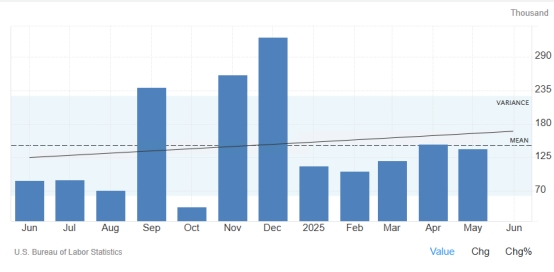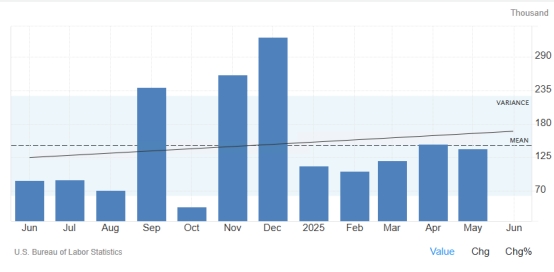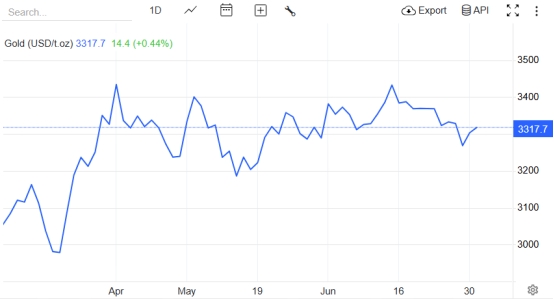Non-farm data outlook for June 2025: Employment picture in the fog
- 2025年7月2日
- Posted by: Macro
- Category: News

1. Non-agricultural Preface - Data Complexity and Market Game
As the core observation of the Federal Reserve's monetary policy, the fluctuation of the US non-farm payrolls data not only reflects the health of the labor market, but also directly affects the pricing logic of global assets. The current market is in a critical period of the game between "high inflation stickiness" and "economic slowdown concerns". The performance of the June non-farm payrolls data will further verify the pace of labor market cooling and affect the pricing of the Federal Reserve's September rate cut expectations. It is worth noting that the previous value has been revised down by 95,000 people, and the deviation between the recent non-farm payrolls and market expectations has increased significantly. For example, although the 139,000 new non-farm payrolls in May exceeded expectations, the previous data itself has the risk of statistical revision.

2. Interpretation of Small Non-farm ADP and Large Non-farm
Small non-farm ADP outlook
Previous value and forecast: ADP employment increased by 37,000 in May, the lowest growth rate in five months, indicating that the private sector's willingness to recruit has significantly cooled. The market predicts that ADP may rebound to 105,000 in June.

The core quota of the big non-agricultural
Previous value and forecast: In May, non-agricultural employment increased by 139,000 people, the unemployment rate remained at 4.2%, and the hourly wage increased by 0.4% month-on-month and 3.9% year-on-year. The market expects that non-agricultural employment will increase by 120,000 people in June, the unemployment rate will rise slightly to 4.3%, and the hourly wage will increase by 0.3% month-on-month and 3.8% year-on-year. However, there are significant differences among institutions, with Goldman Sachs predicting 140,000 to 160,000 people, and Wells Fargo being more pessimistic at 115,000 people.

3. Review of historical non-agricultural data
According to the data from the U.S. Department of Labor, the initial value of non-agricultural employment in March 2025 was 228,000, the unemployment rate remained at 4.2%, and the hourly wage increased by 0.3% month-on-month and 3.8% year-on-year; the data for April was significantly revised down to 117,000, the unemployment rate was still 4.2%, and the hourly wage growth slowed to 0.2% month-on-month and 3.7% year-on-year; the non-agricultural employment in May was 139,000, which exceeded expectations, but the previous value was revised down by 95,000 cumulatively, the unemployment rate remained at 4.2%, and the hourly wage rebounded to 0.4% month-on-month and 3.9% year-on-year. The data showed the characteristics of "slowing employment growth but salary resilience", reflecting the uncertainty of the pace of cooling in the labor market.

Mainstream institutional views
Goldman Sachs: It is expected that the non-farm payrolls will increase by 140,000 to 160,000 in June, the unemployment rate will be 4.3%, and the hourly wage growth rate will slow down to 3.8%. It is believed that the labor market has cooled down but has not stalled.
Wells Fargo: Forecasts an additional 115,000 jobs and an unemployment rate of 4.3%, emphasizing the depressing effect of tariff shocks and government hiring freeze on employment.
Bank of America: Expected to add 150,000 jobs and unemployment rate 4.2%, pointing out that the resilience of employment in the service industry may support data exceeding expectations.
Market median: The median forecast of 69 institutions is an increase of 130,000 people, an unemployment rate of 4.2%, and an hourly wage increase of 0.3% month-on-month.
Key conflict points
Dispute over data authenticity: There is a significant difference in employment data between the corporate survey (CES) and the household survey (CPS). The former shows 2.8 million new jobs in the past year, while the latter only 216,000, suggesting that actual employment growth may be somewhere in between the two.
The relationship between wages and inflation: If the hourly wage growth rate remains above 3.8%, it may strengthen expectations of inflation stickiness and slow the Fed's pace of interest rate cuts; conversely, if hourly wages weaken, it may exacerbate concerns about an economic recession.
5. Trading reminder: long and short logic and strategy of non-agricultural market
Gold Market Strategies
Scenario Analysis:
Non-farm payrolls > 200,000, unemployment rate < 4.2%: strengthens the Fed’s hawkish stance, bearish for gold.
Non-farm payrolls 4.3%: expectations of rate cuts rise, bullish for gold.

ISM Manufacturing PMI (July 1)
Forecast: The market expectation is 50.5, the previous value is 48.5. If it rebounds to the expansion range (>50), it may ease concerns about economic recession and be bearish for gold.
Impact logic: Manufacturing employment is highly correlated with non-agricultural data. If the PMI employment index rebounds, it may indicate strong non-agricultural performance in advance.
U.S. Senate vote on "Big Beautiful Bill" (before July 4)
Core content: It involves tax relief, debt ceiling adjustment and immigration policy. If passed, it may ease government debt risks and boost the US dollar in the short term. If it fails, it may trigger market concerns about fiscal deadlock, which is good for gold.
Speech by Federal Reserve officials (July 2-3)
Focus: If Powell and other voting members send dovish signals on inflation and employment, they may set the tone for non-farm data in advance.
The June non-farm payrolls data will be a key node to verify the narrative of a "soft landing" for the US economy. The market needs to focus on the synergy of employment growth, unemployment rate and wage changes. For gold, in the short term, it is suppressed by the Fed's hawkish expectations and the cooling of risk aversion, but in the medium and long term, it will still benefit from global central bank gold purchases and the risk of a US recession. Investors should adjust their positions flexibly and strictly control risks based on the actual performance of the data.
